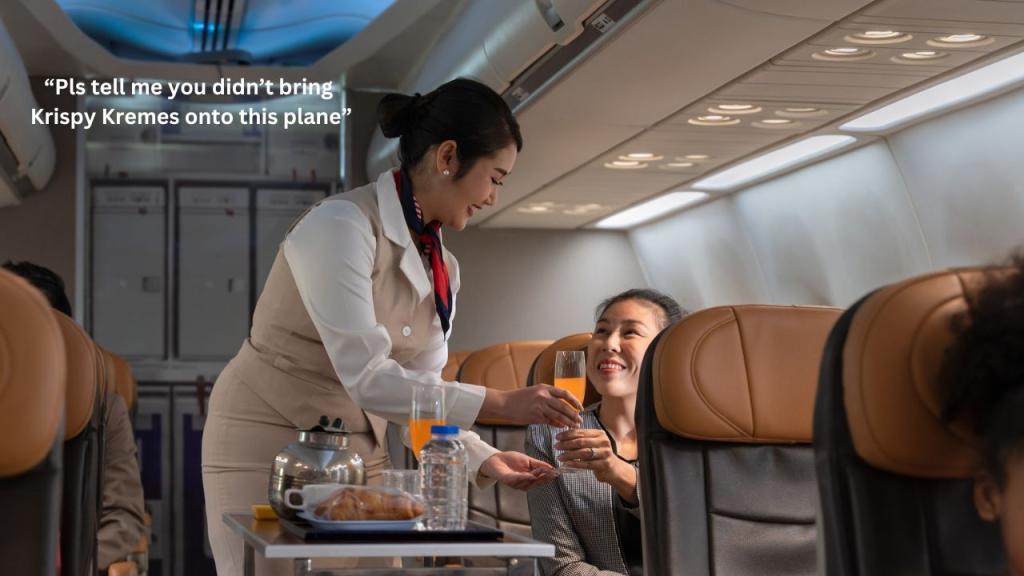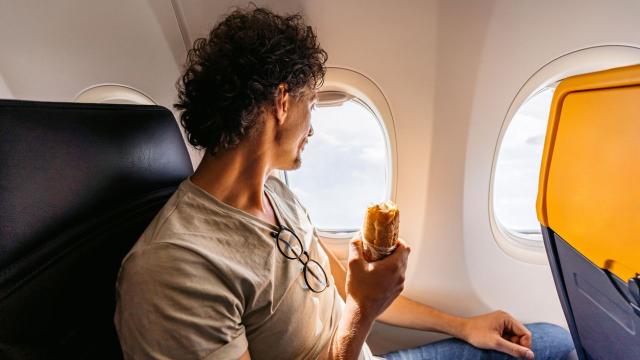As the Summer holiday season approaches, a lot of Australians will be getting onto planes to fly across the country and across the world. Australia is a very big place, and it takes quite a while to get from here to, well… anywhere at all, so naturally, folks do get a little peckish, and it can be a great alternative to the general lack of quality you’ll find in a lot of airline food.
Equally, it can be tempting to grab something local to take to friends you’re visiting as a gift, or something to bring home to remind you of your trip when you’re back to work. You’ve got the capacity in your carry on, so you plan to just take it with you, right?
Wrong. There are a number of foodstuffs that are just a bad idea to take into any airline cabin, for a variety of reasons. Here’s a list of some of the worst.
5 foods you should never bring on a flight

Those huge Krispy Kreme boxes (or any other similar ‘novelty’ size food box):
Krispy Kreme made a lot of money out of a lot of Australians back when they were first new and novel, so much so that there was an absolute trend of folks travelling interstate to grab a box and bring it home with them. More than once, I’ve been stuck on a flight next to the guy who decided to bring what felt like his entire body weight and mass in Krispy Kreme boxes.
While taking pastries on domestic flights isn’t illegal, the reason why you shouldn’t do this is twofold. Firstly, Krispy Kremes are grossly overrated.
(Author ducks beneath stale doughnut thrown by the Krispy Kreme-loving crowd.)
OK, there is a secondary, much more important reason. Taking them onboard a flight is a recipe for disaster, and it’s pretty inconsiderate to your fellow passengers.
I’ve been on flights where people have stowed them above themselves, only to see them crushed by another bag next to them.
I’ve sat next to people holding them in their lap, at which point (especially on smaller planes) it’s really hard for anyone (including the owner) to move around if they have to. I’ve been on flights, too, where somebody stumbled and landed more or less in the lap of a Krispy Kreme box holder… at which point their precious doughnut hoard was squashed entirely. The same concept applies to other oversized food packaging, too, whether it’s grossly oversized Pringles tubes or those massive celebratory Toblerones.
Save your money, support a local bakery, and get something sweet when you land.
Tim Tams from Australian Airports (or any local ‘quirky’ snack from an international airport):
As Australians, we’re very proud of the Tim Tam. Which is odd, because the whole thing’s based off a UK biscuit called the Penguin, but putting the two side by side, the Tim Tam is clearly the superior chocolate biscuit snack, and it’s not even close. That’s why, at most Australian airports, it’s possible to buy packets of Tim Tams. The Tim Tams don’t care if you’re buying them to impress overseas relatives or if your plan is to scoff them the moment the flight takes off.
Still, you shouldn’t. Not because of the bellyache you’ll experience later, but simply because, most of the time, they’re overpriced. Sometimes grossly so, and especially because the popularity of Tim Tams means that they’re very often on sale in at least one of the big supermarket chains near you. Stock up before you travel, chuck them in your checked luggage and save yourself a fortune.
The same tip applies to a lot of ‘fancy snack’ items you might buy overseas, too. If you’ve ever been keen on some of the more unique flavours of Kit Kat you can get in Japan, the general worst place to buy them is at Tokyo’s Narita or Haneda airports, for example – unless you’re somehow allergic to money. If there’s a local delicacy that you’re going to be allowed to take back into Australia, buy it where the locals buy it – and not from the airport (but see below for a reminder on that issue, too).
Surströmming (or other considerably fragrant foods):
If you’re not familiar with Surströmming, it’s a traditional Swedish fermented fish dish, and if the sound of the words “fermented” sounds good to you, then, by all means, book your next holiday in Sweden.
It’s not a good idea, however, to plan to bring Surströmming back with you; it’s not permitted on a number of airlines because the fermentation process makes the fish particularly pungent. There’s concern there about broken cans, but also about the effect it might have on your fellow passengers if you decide a mid-trip snack is on the cards. Other famously nostril-assaulting foodstuffs such as Durian typically fall under the same rules. That’s not to say that they’re not edible, generally speaking – neither would last as foodstuff if somebody didn’t like them – it’s just to point out that Airline flying is stressful enough for most of us without somebody stinking out the metal tube we’re all going to be spending the next 2-20 hours on.
Some of these foods are also a bad idea for you on a plane, because even if (in theory) you could neck an entire tin of Surströmming in the bathroom without leaving a trace of odour, you’re taking in a lot of potentially stomach-upsetting flavour in one hit that’s likely to leave you feeling a little queasy. Being stuck on a plane and feeling sick is the worst, so even if you won’t do it for the sake of your fellow passengers, do it to save yourself the digestive stress.
Big bottles of water:
Look, I get it. Airline flights, especially economy ones, are notorious for providing very little water during flights. Maybe you’re also not a fan of the way that many airlines these days give you those tiny plastic water bottles when you board the plane, because you’re concerned about the environment. Still, while I feel like this one should be very well known, you’re not allowed to take big bottles of water (or other ingestible drinks, sorry, Coke fans) through security at Australian airports. Anything greater than 100ml (even if it’s only partially filled) isn’t allowed, and yet, pretty much every time I go through an airport, I’m stuck behind people who don’t seem to get this.
Again, there’s a Tim-Tam style trap here, because you can buy bottles of water (or other fluids) at the stores past security, typically at quite a markup. Those bottles should have been extensively screened, but there’s a much easier way to avoid that cash trap. It’s to hydrate sufficiently (but not excessively) before heading to the airport, and when needed, use the bell to call the inflight service staff if you need more water to stay hydrated.
Lots of fresh food (coming back into Australia):
Again, this feels like it should be a rather obvious and well-known matter, but then again, if it was, our airports wouldn’t need all that signage or dump bins in place.
Australia has serious and strict biosecurity laws that govern what you’re allowed to bring back into the country if you’ve been overseas. The general rule of thumb here is that a lot of foodstuffs should be declared at least, and many are not permitted into the country. The ABF has an excellent guide and resource that walks you through what you need to do in terms of different foodstuffs here, which is well worth perusing if you’re in any doubt. While what happens if you declare something that shouldn’t come in does rest with the discretion of the customs officer to an extent, if you fail to declare items that you bring in, you can face significant penalties – so the easiest route to take is to simply not bring them on board the plane at all.

Leave a Reply
You must be logged in to post a comment.